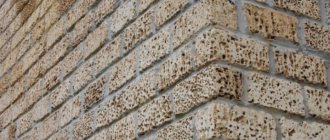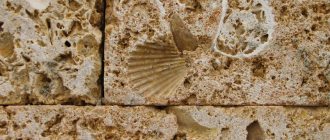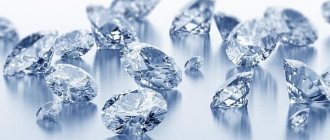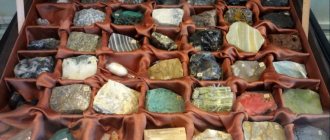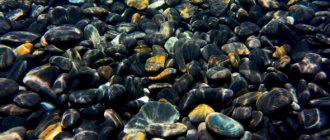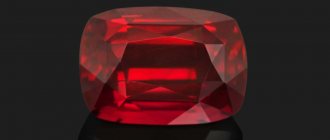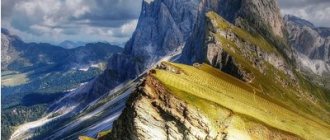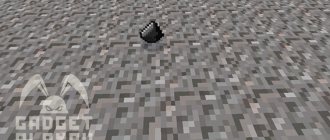Origin of shell rock
The main deposits of this natural stone are located in the southern regions, where prehistoric seas used to overflow: Moldova, Odessa region, Crimea , most of the Alps, Turkmenistan, Azerbaijan. As the name suggests, this building material consists of shells and shells from marine animals that lived in these seas.
Over time, the seas dried up, the shores and bottom were exposed along with the remains of these sea creatures that settled in them. Even now, skeletons of these prehistoric animals can be found on sections of shell rock slabs. Under the influence of natural conditions and the severity of years, all this was compressed to the hardness of stone.
Laying shell rock walls video
Watch a video about laying shell rock: If you are building the first floor of a residential building, then it is better to place the shell not in the floor of the stone, but in the stone. And the upper floor can be made with half a stone, only in this case it is highly advisable to insulate the building. Polystyrene foam can be used as insulation.
Watch the video of laying walls made of shell stone using an example: If you have never laid stone, it is better to contact specialists, where you can save on finishing, because... The smoother the stone is laid out, the smaller the layer of plaster will be used for finishing.
For the lower floor it is better to use denser shell rock, for example brand M-35. For upper floors and laying walls in high-rise buildings, you can use stone grade M-15 and grade M-25.
It is highly advisable to reinforce every third or fourth row to strengthen the structure. Do not skimp on mortar when laying shell rock.
Typically, the solution is formed according to the following proportions: 3 portions of sand per 1 portion of cement - diluted with water until plastic. It is forbidden to lay shells in frosty weather.
Composition and main characteristics of the material
Shell rock is limestone consisting of calcium salts. Moreover, regardless of the place of extraction, the composition remains approximately the same: calcium carbonate - 52.06-55.66%, magnesium oxide - 0.19-0.71%, carbon dioxide - 41.16-43.62%. Under the influence of acidic water, the calcium contained in the shells decomposes, releasing carbon dioxide.
This determines the presence of pores in the structure of shell rock and the emergence of mineral springs. The main color is white-yellow, light yellow. Depending on the presence of impurities, the color may be different: iron gives pink shades to shell rock, copper – blue, coal – from gray to black.
Due to the fact that shell rock was formed in places of former seas and from the remains of marine animals, it releases vapors of iodine and sea salt and has good antibacterial properties. In a room decorated with this material, a specific composition of air appears, which strengthens the immune system and improves overall health.
This especially helps people with cardiovascular diseases and those who have problems with the upper respiratory tract and the thyroid gland. Many resorts around the world are famous for their shell rock beaches with healing air.
Shell rock is a natural stone , therefore it is an environmentally friendly material. Compared to others, it has a neutral radiation background - 13 μg/h, with a minimum acceptable level of 25 μg/h. At the same time, it perfectly protects against dirty air, radiation and other harmful radiation by 100%. This is the only material capable of this.
Another very important advantage over other building materials is that mice and rats do not like a house made of shell rock. For a country house this is a significant indicator.
The presence of pores is the reason for the low thermal conductivity of shell rock - 0.2-0.6 W/m-C°, while for brick it is 0.55-0.64, more than two times more.
The situation is the same with sound insulation. Therefore, the use of this material eliminates the need to additionally insulate and protect the walls of the house from noise, which provides significant savings in construction. In addition, shell rock has very high frost resistance - up to 70 cycles, so you don’t have to worry about the integrity of the exterior decoration of the walls of the house, unless you go to change it yourself.
Shell rock is very inert, therefore it does not react with other building materials, therefore, it will not collapse itself and will not subject other substances to deformation.
Laying shell walls
First of all, to lay shell rock, masons will need a plastic masonry mortar. With a mortar that is too hard, it will be almost impossible to lay shell rock evenly even for experienced masons. A good masonry mortar should be easily pliable, but not flow.
The optimal composition of the mortar for laying the walls of a shell rock house is as follows:
- 1 bucket of PC-400 cement; - 4 buckets of sand; - approximately 1 bucket of water.
If you mix such a composition without additives to the mortar, it will be excessively hard and unsuitable for masonry. If you try to correct this by adding more water, the solution will quickly delaminate and lose the required plasticity. Therefore, it is imperative to use a special additive, which gives the masonry mortar plasticity.
An example of such an additive is DOMOLIT-TR. To prepare 1 m3 of solution, you will need approximately half a kilogram of this additive. The exact dosage can be found in the instructions. If it is not possible to buy a special additive for masonry walls, you can instead use ordinary liquid soap or detergent for washing in an amount of 10 ml per 1 liter of water to mix the solution.
When the masonry volume is 5000 shell rock blocks or more, it is advantageous to use a concrete mixer to mix the mortar. Without it, the productivity of the masonry team will decrease; in fact, it will be necessary to allocate one auxiliary worker only for mixing the masonry mortar. Therefore, the concrete mixer will quickly pay for itself. In addition, it can be used in the preparation of concrete and mortar for other work during the construction of a house.
If the volume of masonry work is small, then the solution for laying shell rock can be mixed by hand. It is most convenient to simply knead on a steel sheet or any other durable, water-resistant surface.
Building a house from shell rock will require the following tools:
- trowel; - rubber mallet; - nylon thread; - building level; - measuring angle; - buckets for mortar.
Pay special attention to the quality of the building level. The accuracy of the masonry depends on this tool
It is not recommended to buy cheap building levels with a flimsy bar. It is also best to buy steel buckets; plastic ones break quickly.
Laying the outer walls of a house made of shell stone, like any other stone, starts from the corners. Exactly drawing the corner of the walls is the most important, time-consuming and, without exaggeration, difficult work, especially considering the poor geometry of the shell rock blocks. Therefore, only the most experienced masons should be trusted to lay corners. If you will do the masonry yourself without experience, then it is best to invite a mason to show you how to do it correctly using a building level.
When the shell rock blocks are correctly installed at the corners, it is relatively easy to lay a row between them. To do this, a nylon thread is stretched between the corner blocks (highlighted in red in the photo). The thread can be tied to two nails and secured by pressing down with a brick or half a block. It is not advisable to place a whole stone on fresh masonry, since it can push the moving mortar under the corner block with its weight.
The block must be placed so that its upper corner “looks” into the thread, but not closely, but at a distance of 2 mm. If you apply the block closely, the thread will be pressed through and the row will turn out to be an arc. Leading the masonry along the thread, you will never make a mistake.
When laying a wall of a house one stone wide, the masonry should be tied every fourth row. The dressing can be done either by laying a row of blocks with a poke, that is, across the wall. Or by placing a 50x50x4 mm masonry mesh in the seam. The bandage binds the wall of the house, makes it stronger, a single monolith.
Based on their density, there are three types of shell rock:
M15 is the loosest , with large pores, and very loose in appearance. It comes in different colors - from white to brown, but most often yellow, for which it received the nickname “yellow”. The yellowish tint is given by the presence of sand impurities, which have a higher thermal conductivity compared to the shell rock itself. Therefore, this brand is the coldest among other brands.
When hitting a hard surface, an M15 block breaks into several parts. In terms of weight, these blocks are the lightest (8-12 kg), so their surface may be damaged during loading and unloading operations. Subsequently, in order to level the surface, a large amount of plastering work may be required. Despite this, it is successfully used in the construction of garages, outbuildings, fences, bathhouses, and upper floors.
M25 is a shell rock with medium density and porosity. The main color is light yellow, sand. If dropped, it rarely breaks in half, and even less often into three parts. The most popular brand in construction, as it is superior in strength to brick, gas and foam concrete. Widely used for the construction of two-three-story houses. In frame and panel construction, interior partitions are made from this brand of shell rock. Block weight – 14-17 kg.
M35 is the densest and most durable grade of stone and has the lowest porosity. The color is almost white, yellow-white. The heaviest of all brands (22-25 kg), therefore ideal for laying foundations, basements, and ground floors. White shell rock is stronger than yellow shell rock.
Features of shell masonry
In blocks depends on its size and vintage. The latter indicator can vary from M 15 to M 35. The number here means the compressive strength of the material. If the compressive strength is low, the material is not suitable for construction due to its fragility, and if it is too high, the house will be too cold due to the high density of the material. The best option would be blocks with medium density. They are also quite easy to work with: they can be cut using any hand tools.
Masonry from Crimean shell rock blocks can be done in three main ways:
- single-row;
- two-row;
- three-row.
In each case, ligation of the sutures must be done.
If a multi-row masonry method is used, it should alternate between spoon and bonded rows. Single-row masonry, in turn, is produced during the construction of a half-brick wall.
In all cases, especially close attention should be paid to the high-quality filling of vertical joints. In some cases, solutions for laying shell shells have to be poured into them from above
A high-quality masonry composition is an important component of successful construction.
You should never skimp when preparing it. And any mistake can be fatal. If you are not confident in your own abilities, do not take risks. Entrust the preparation of the solution to experienced, qualified specialists or purchase a ready-made mixture from a reliable manufacturer.
Shell rock is a natural material consisting of the shells of sea animals. The closest place of its extraction and production for Russia is Crimea. It was in the southern regions that it gained its popularity most of all.
Shell rock is a natural material consisting of the shells of sea animals.
Marble and limestone are also natural materials similar in composition to shell rock, but their density is much greater than the latter.
Shell rock is excellent for making walls of houses, barns, and foundations of various buildings.
Shell rocks are formed over hundreds of years under the influence of external conditions from mollusk shells settling on the bottom. When extracting it, the rocks are found to be red-brown, yellow or brown in color, which is easily deformed when sawed out. Despite the porous structure of shell rock, it is strong enough and suitable for the construction of even three-story buildings. Excellent sound insulation and thermal conductivity are attractive qualities of this material during the construction process. A house or building built from shell rock will never have an excess amount of moisture inside. This is explained by the fact that all its excess is removed through the porous walls of the shell rock.
The cost of a building built from this material is much lower than the cost of a brick one, this provides additional benefits to the owner. In addition, in private houses, attic floors are built from shell rock, since the attic should not be heavy.
Making shell rock
The material is extracted by quarrying using special machines that cut layers of shell rock.
Even in one quarry, the structure and color of the stone changes depending on the depth of the layer. Despite its strength, shell rock is easy to saw even with a hand saw and you can get slabs and blocks of various sizes without much difficulty. For the same reason, it is possible to manufacture parts of various shapes and sizes, for example, columns. The standard size of blocks is 18x18x38 cm, or 20x20x40 cm. There are 5.5 bricks in one shell rock block. When processing slabs, they are given different types of surfaces: regular sawn, polished, rough.
Features of shell masonry
There is perhaps only one difference from the technology of masonry made from lightweight concrete blocks - it is more difficult to build a stone wall with a variation in geometric dimensions, and the variation reaches 30 mm and above. In addition to the overconsumption of mortar for the seams, the thickness of which is required to be 20-30 mm in order to align the rows, there is also the issue of the mortar itself. You need a solution with very good plasticity, but dense, so plasticizers are used in large doses. The masonry is carried out as usual - from the corners along the lighthouse cord and with horizontal and vertical alignment. The thickness of the walls is taken to be one or one and a half stones. Walls 580 mm thick do not need an additional layer of insulation; they are only plastered. For internal non-load-bearing partitions and walls of outbuildings, edge-on masonry with a thickness of 180 mm is sufficient.
It is impossible to leave shell walls without external plaster in the fall and winter; drainage from the roof also needs to be addressed without delay. Roof overhangs and canopies are made large - 60 - 70 cm.
Regarding the issue of armored belts, everything is decided individually and depends on many factors - the number of storeys of the house, seismicity of the construction area, soil properties and the type of shell, and of course, it is linked to the width of the masonry. The need for a base reinforced belt is more a question of the foundation; if there is a slab at the base, a lower reinforced belt is not needed. But under the ceiling and the mauerlat, armored belts are often poured, since the shell is still a fragile material. M35 grade stone can withstand both the weight of two floors and the reinforced concrete version of the floor. The M25 grade also withstands reinforced concrete hollow-core floor slabs, but still builders often decide on the need for an armored belt. As an option, reinforcement is arranged by casting columns at the corners of the house and combining them with an armored belt. This option gives the house even more architectural expressiveness.
How does limestone form?
Living marine organisms, large and small, are very important in the formation of limestone. Developing in the depths of the sea in huge quantities, these marine inhabitants multiply incredibly quickly, but die just as quickly
During their existence, microorganisms manage to extract enough lime from the water in order to equip their body with reliable protection in the form of shells or various shells. Subsequently, the skeletons of dead microorganisms lie on the seabed in entire layers.
Over time, these layers are pressed by the water mass, become strong and eventually turn into stone, the main component of which is calcite. As a result, the amount of calcium carbonate is 60% of the total mass of limestone. The rest consists of carbon dioxide and minor clay impurities. It is the impurities that color limestone in different colors.
Healing properties of fossils
The healing properties of ammonite have been used by healers since the discovery of the stone. Since it contains only natural substances found in nature, it has a positive effect on health. According to popular belief, it helps well with sleep problems: its properties allow you to get rid of nightmares and insomnia, and improve your mood after waking up. In ancient times, healers used shells as a sedative. Lithotherapists highlight the following healing qualities of ammonite:
- elimination of depression and apathy;
- improving blood composition and restoring normal blood circulation;
- slowing down the aging process;
- relief from chronic fatigue;
- increasing resistance to colds;
- elimination of skin rashes;
- therapy of childhood diseases (measles, scarlet fever, chickenpox, etc.);
- treatment of infertility and improvement of pregnancy.
Due to their ability to harmonize human energy, ammonites are actively used today in China. Applicative applications and stone massage are popular. They stimulate the functioning of body systems and normalize blood flow. During the massage, movements are performed in a spiral, repeating the curls of the fossil.
